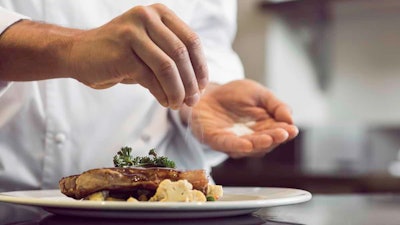
Have you been using salt wrong all your life? Are you marinating too long, thinking that it's necessary for flavoring? Find out which cooking techniques are the subject of heated debates among seasoned chefs and which side of the table you're on.
Should you salt before or after cooking?
There's no doubt that salt is essential for seasoning but chefs may disagree about the best time to use it. For meats, some strongly recommend salting before cooking - known as dry brining - to give the salt more time to season the meat and tenderize the texture.
Other chefs oppose this method and prefer to salt just before or right after cooking. They argue that this prevents too much moisture from being lost and provides greater control over the final flavor.
Unfortunately, there is no black-and-white answer. The optimal timing for salt depends on the ingredients and your preference for texture. Dry brining can work well with meat, but adding salt too early on for vegetables can negatively affect their texture.
Water-bathing food
"Sous vide" is a French cooking technique that involves heating food in a vacuum-sealed bag at a precise and consistent temperature in a water bath using various accessories. Many chefs love this technique for evenly cooking food while retaining its juices, especially for meats.
The argument with sous vide is that some people find it's missing the art and skills of traditional cooking, such as searing and browning, to allow the dish to develop complex flavors. Water-bathing food at a precise temperature takes away the fun and finesse that make cooking so enjoyable for many.
How long should you marinate?
If you ask chefs what the marinating time for a dish should be, you'll probably get varying answers. Some chefs prefer marinating for a short period, like 30 minutes to two hours. This allows enough time for the flavor to seep in without sacrificing texture. Acidic marinades in fish or, especially, chicken can break down the proteins if left for too long and you get a mushy texture.
Others don't believe a few hours is enough and want a longer marinating time, from adding more hours to overnight, for stronger flavor penetration. This is often done for tougher cuts of meat that will soften from the long soak.
The right technique is to change the marinating time depending on the food and what's in the marinade. For something like chicken roll ups, you just need to sprinkle salt and pepper and a few other seasonings before you cook, but for a tough beef cut, you probably need to marinate it overnight.
The gold flakes trend
Using gold flakes to garnish food is a controversial topic among chefs. Some find that edible gold on food adds a dash of harmless luxury that elevates the dish. Many disagree with that stance and believe it's wasteful since gold is tasteless and contains no nutritional value.
The infamous Salt Bae, a Turkish butcher and chef who became popular on social media for his unique method of sprinkling salt onto meat, made headlines once again for his new recipe: A 24-carat gold steak. His video sharing this dish received thousands of negative comments as people found it a distasteful display of wealth.
Is resting meat necessary?
Resting meat relaxes the muscle fibers and allows the juices to redistribute throughout the meat, resulting in a more tender and flavorful cut. The resting time can range from five minutes for smaller roasts to 20 minutes for larger ones. If you've just cooked some sausage and sauerkraut in the oven, it may be a good idea to let it sit for a bit to prevent hot juices of fat from squirting out after a bite.
Other chefs believe it's an overrated technique that leads to a cold dish and can even potentially overcook the meat as it sits in the residual heat. Another con to this is that resting makes a steak's crust soft. That's why some chefs prefer to eat the meat right after cooking to savor the immediate flavors instead of letting it rest.
Food presentation: A waste of time or a form of art?
Those passionate about food presentation advocate that it's a crucial part of cooking. From choosing the right plate to using edible garnishes like flowers or herbs and playing with contrasting colors, food presentation is a form of art in itself.
The heated debate comes from the rise of aesthetic dishes that sacrifice taste for looks and to be TikTok-worthy. This trend is becoming common in high-end restaurants that charge expensive prices for a pretty dish that lacks flavor. Sure, food plating makes the meal look more appealing and classy, but sometimes more thought is put into the dish's appearance than the actual cooking process.
Hot takes on deglazing
After searing meat, you often have caramelized bits stuck to the pan, also known as fond, which is a nightmare to clean up. Deglazing involves dissolving the bits into a liquid using stock or wine and creating a pan sauce to let the meat sit in.
Those who advocate for this step believe it helps build layers of flavor and is an easy sauce to make. Other chefs disagree and argue that the fond can create a burnt or bitter taste and that skipping deglazing will not greatly affect the dish's taste.
If you decide to deglaze, make sure you're not using non-stick cookware with a Teflon coating. Learning how to create a non-toxic kitchen is essential to any cooking technique, including deglazing.
Settling the debate
Cooking, much like art, is somewhat abstract, with differing views on the right techniques. Debate arises from personal preferences on how individuals like to enjoy their food. Whether it's adding salt after cooking or resting meat for a longer period than others prefer, cooking is all about experimenting, innovating and finding your unique culinary style that suits your taste buds.






















